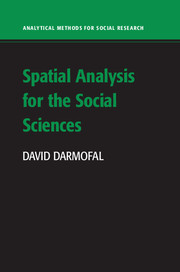Preface
Published online by Cambridge University Press: 05 November 2015
Summary
This book is designed for social scientists who seek to model the spatial dimension of behavior that is inherent in substantive social science theories. The social sciences are united by their focus on subjects that are inherently social and interdependent. Unlike more individuated concerns, the units studied by social scientists often interact with each other and affect each other's behavior as a consequence. This interaction is promoted by spatial proximity – units that are more geographically proximate are more likely to interact with each other and influence each other as a consequence. Shared concerns combine with spatial proximity to promote familiarity. Just as familiarity has long been observed to breed contempt, so also does it promote cooperation. Even when spatially proximate units do not interact with each other, they often exhibit similar behaviors as a result of shared environmental influences. In short, there is a strong spatial component to many of the behaviors studied by social scientists and this is reflected in many of our theories in the social sciences.
It might surprise social scientists who have not seriously considered the spatial dimension of behavior to learn that all social science data are, in fact, spatial data. The behaviors, processes, and events of interest to social scientists occur at specific geographic locations. The past two decades have seen an explosion in social science data that are geocoded – coded to include the geographic locations of the observations. This increase in the availability of geocoded data has been matched by advances in geographic information system (GIS) software, such as ESRI's (Environmental Systems Research Institute) popular ArcGIS package. At the same time, significant advancements have been made in the development of spatial diagnostics and estimators, many of which are now included in dedicated spatial software such as GeoDa as well as standard statistical packages such as R, Stata, and WinBUGS. The time has never been better for scholars wishing to model spatial relationships in their data.
- Type
- Chapter
- Information
- Spatial Analysis for the Social Sciences , pp. xv - xviiiPublisher: Cambridge University PressPrint publication year: 2015

